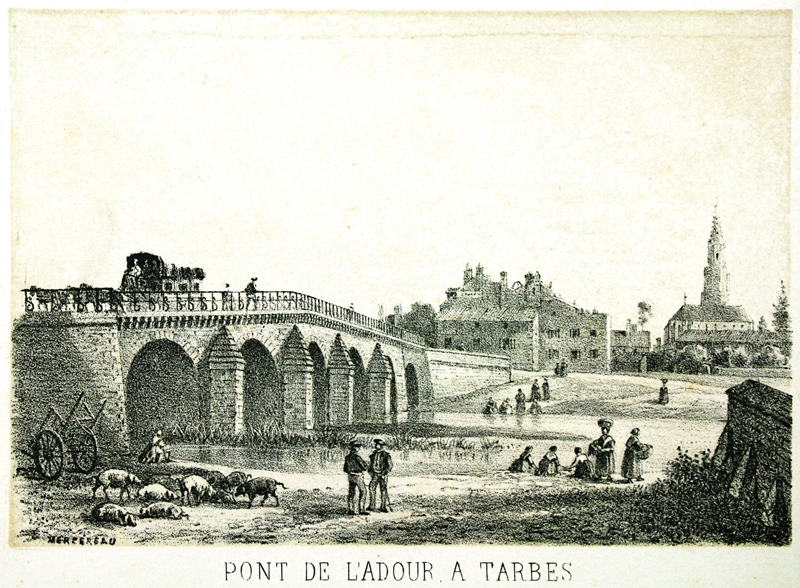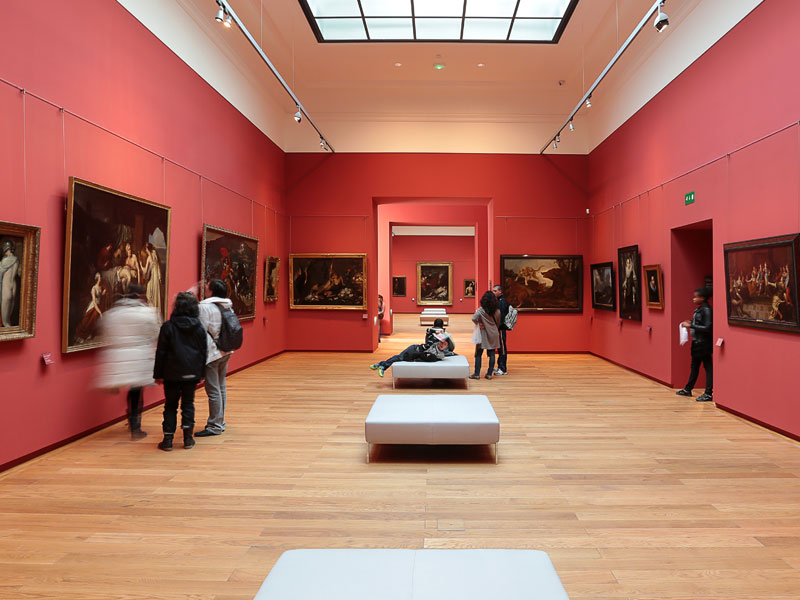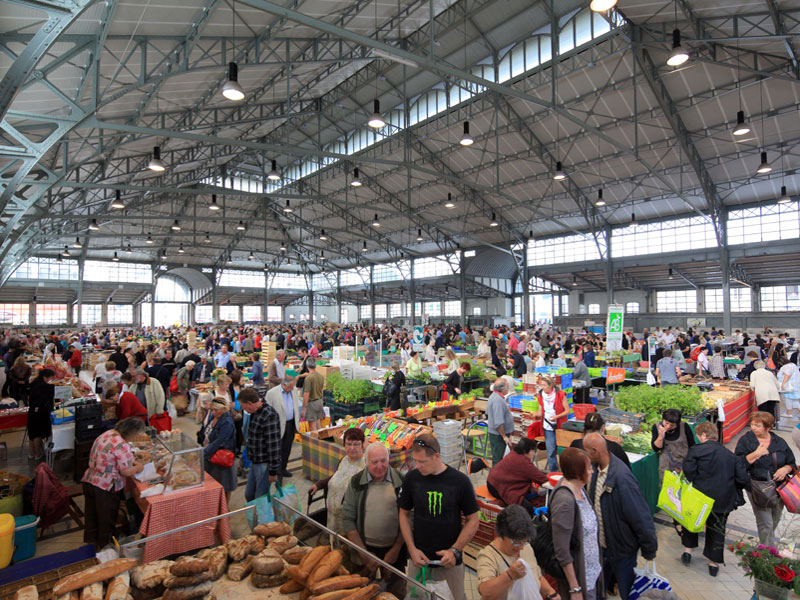Some historic background
Tarbes, capital of the department
Right from the Middle Ages, the origin of Tarbes can be summarised with the story of a handful of people who chose
to settle in this great location where two rivers, the Adour and the Echez, meet.
The town then flourished in the 16th century thanks to a booming economy based on craftsmanship and trade.
Tarbes was also entrusted with the management of the entire province.
After the French Revolution, the duties of the town were partly transformed, upon the initiative of Napoleon III and military needs.

For a long time, the towns of Saint-Lézer (next to Vic-en-Bigorre) and Tarbes claimed their position as the seat of the bishopric and capital of the Bigorre region.
These positions were for many years assigned to Saint-Lézer, once known as Bigorra, where the ruins of a significant Iberian and then Gallo-Roman village were found. Well before the town of Tarbes came to the forefront. Indeed, recent excavation work (2018) revealed ruins of even earlier Roman presence around the cathedral. These discoveries helped to strengthen the town’s position as seat of the bishopric.
Near the diocese, the county town expanded around the Château Comtal, which, in the 12th century, became the headquarters for various administrative services.
At the end of the Middle Ages, Tarbes gained new functions and therefore overtook its rivals. The town expanded as a political, strategic, religious, economic, artisanal and commercial hub.
It was thanks to the political and administrative influence and the significant work done by Bertrand Barère at the Constituent Assembly, that Tarbes took over the role of capital. In 1800, the town officially became the headquarters for the prefecture of the Hautes-Pyrénées. The administrative centre was moved to the former episcopal palace, and it is still there today.
Tarbes, little towns inside a bigger one
“Tharbes is a beautiful, big town, in the countryside and surrounded by beautiful vineyards. There’s a town, a historic centre and a small castle, enclosed by doors, walls and towers and each one is separated from one another.”
Jean Froissart, Les Chroniques de Sire Jean Froissart, Livre III (1386-1388)
As early as the Middle Ages, the town was built in a linear configuration of six small towns, each one with separate fortifications and lined up in a row from west to east. This central road is over a kilometre long and is in fact a section of the trade route that crosses the foothills of the Pyrenees from Toulouse to the Basque Country.
The town of La Sède, ‘the bishop’s official seat’, is believed to be the initial core of the town, where the very first settlers came. In this town is the cathedral, the cloister, the episcopal palace and the bishopric, and the administrative services here are independent.
The town of Carrère Longue, meaning ‘the long road’, is today known as the Rue Abbé Torné. From the Place de Verdun to Rue Ramond, this is an ancient medieval way that served as the first section of the central road through the town. In the 19th century, the heavy traffic along this road from Pau meant that an extension was required, but unfortunately this was not possible. That was when a Royal route was created, known today as the Rue Georges Lassalle.
The town of Maubourguet is a small town that served as the intermediary between the bishopric and the county town. When this small town disappeared, a vast urban square was created in its place. When a north-south route was developed, this square became the town’s main intersection. From the 18th century, it became a very popular place for the locals of Tarbes to come to walk. The town centre location made it the perfect choice for organising key events. Over the years, bars, cafés and hotels were built here. This town square kept the name Maubourguet until 1919, when it was changed to the ‘Place de Verdun’ in tribute to the Allies’ victory.
The Bourg Vieux today refers to the area between the Place de Verdun and the Place Jean Jaurès. In the Middle Ages it was overlooked by the Château Comtal and then enclosed by the walls of Rue Foch (Rue des Grands Fossés) and Rue Clemenceau (Rue des Petits Fossés). Aristocrats, doctors, lawyers and senior officials lived here! Incidentally, Théophile Gautier and Bertrand Barère were both born here.
The Bourg Neuf is the area from Bourg Vieux up to the current Rue Paul Bert. It is known as being the arts and crafts and small boutiques district.
The Bourg Craber, known as ‘des chevriers‘, marks the east entrance to the town. It stretches from the Rue Paul Bert as far as the church of the Carmes convent, which was later replaced by the church of Sainte-Thérèse.
Beyond these ramparts built using rounded stones, Tarbes also boasts a rural area with vineyards, meadows, farming land, marshland and gardens.
In the 18th century, the ramparts were demolished and took with them precious evidence of the town’s past, but thanks to this, the layout of the town became much more coherent and created more space.
Tarbes, town of trade and craftsmanship
“If you want to see all the products and traditions of the Pyrenees, you’ll need to go to the fairs of Tarbes. They attract visitors in their tens of thousands, who come from all over France.”
Jules Michelet, Histoire de France (1833-1844)
This small town very quickly became a passage for salt merchands, most likely from the Aquitaine region, who were travelling across the foothills of the Pyrenees.
From the 16th century, Tarbes was a hub for trade and craftsmanship. This was also where some of the key decisions were made regarding the province. The square in front of the church of Saint-Jean became the busy centre of the town and markets and celebrations were held there.
On the far east side of the town, a suburb was for a long time excluded. Every other Thursday, traders from the surrounding area came to sell their goods. The ‘Grand Marché’ (big market) then became well known across the region and the locals and farmers began to flock here. When the town’s first stone bridge, the ‘Pont d’Adour’ was built in the 18th century, the Marcadieu (meaning ‘market’ in Gascon dialect) market became even more popular. On some Thursdays, there are even up to twenty thousand people here. From 1880, a plan was put in motion to build an indoor market in a Baltard-style, with beautiful metallic architecture.
At the end of the 19th century, the economy of Tarbes began to flourish. This indoor market was built in 1883 close to the Rue des Grands Fossés (today, the Rue Maréchal Foch). It was named Brauhauban, after the Mayor of Tarbes in 1875, who made a donation to the town.
Today, the Place Marcadieu is where the biggest farmers’ market in south west France is held, on Thursday mornings. Brauhauban market is a daily market.

Tarbes, military town
Tarbes became a military town from 1806 when the Haras National was developed here by Napoleon I. To satisfy the needs of the cavalry and provide the much-needed horses for battle, it was decided to build this stud farm in Tarbes. Cross-breeding was done here, using the Navarin horse, a breed from the Pyrenees that is now extinct. A new Anglo-Arabian breed was therefore created, a strong and quick horse that was ideal for battle.
After the war of 1870, the military purpose of the town grew more significant. Tarbes also flourished as an industrial, working-class town thanks to the ‘Arsenal’, an artillery building workshop established by Artillery General Verchère de Reffye.
As a result, a number of new districts and barracks were set up, the most well-known being the Larrey (today, the 1st Parachute Hussar Regiment) and Soult (today, the 35th Parachute Artillery Regiment) districts, as well as Foix-Lescun, the Reffye barracks and Massey.
When the First World War began, the rural geographical location of Tarbes made it possible to increase artillery production in order to supply the army. This war was won by the Allies, led by the famous Marshal Foch, who just happened to have been born in Tarbes in 1851.
In the Second World War, this strategic position made the town just as vulnerable as it was sought-after. When the Germans took over the daily running of the town, the Arsenal was no exception. Tarbes played a key role in the Resistance and the town was eventually liberated. The town was awarded the Croix de Guerre (war medal).




